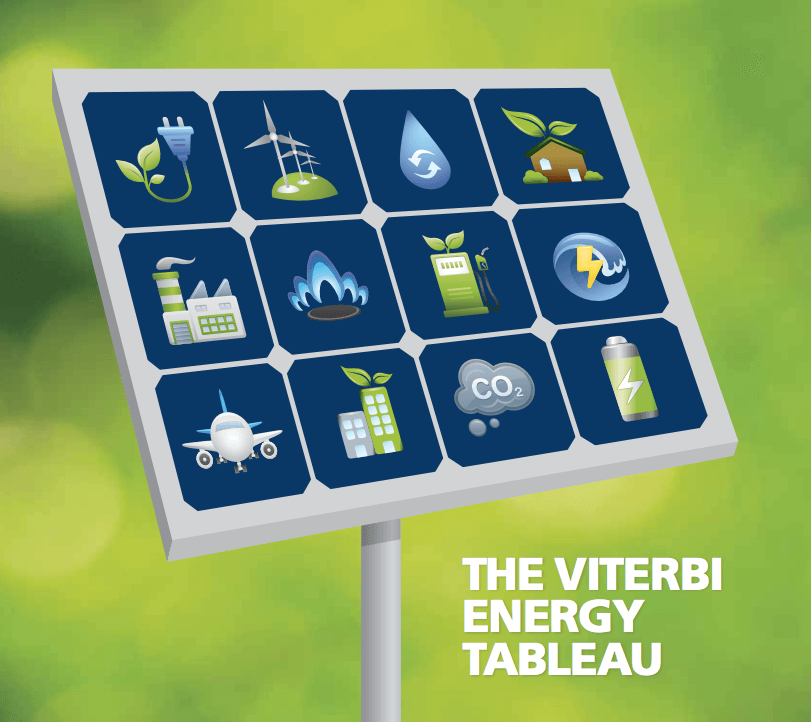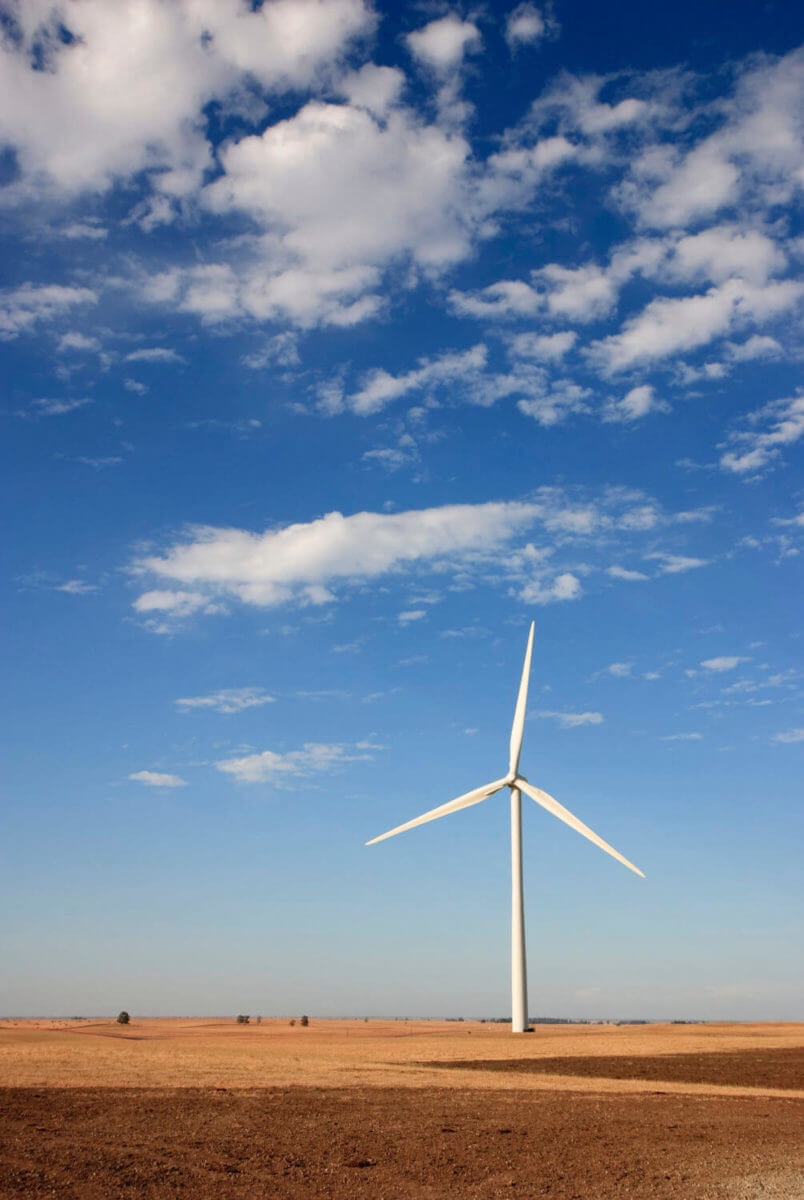Energy & Sustainability Initiative
Power at our fingertips to fuel everything from computers and appliances to motorcycles and jetliners--modern civilization depends on it.
Yet, the 21st century presents a myriad of challenges concerning energy: Where will the power we need come from? How much will it cost? Will there be enough to sustain a rapidly expanding world? And can it be harnessed with the least amount of harm to the environment? Indeed, energy issues have emerged as one of the key grand challenges facing our society.
The University of Southern California Viterbi School of Engineering pursues research in various areas of the energy challenge. This site summarizes the research centers and programs, and the educational programs that are part of the VSoE Energy Initiative.
The Viterbi School's activities fit into a broader panorama of research at the University of Southern California.

Transforming, transmitting and utilizing energetic content, from kinetic to internal energy, is at the heart of energy engineering: from wind turbines to combustion to nuclear reactors to the capture and transformation of solar energy. At the USC Viterbi School of Engineering, energy research addresses sides of the energy equation: On the supply side, by focusing on solar energy systems, on carbon capture and sequestration and on improving efficiencies in energy extraction. On the demand side by improving efficiencies in utilization in various settings, particularly transportation and urban systems.
One major change has entered the field in recent decades. The breathtaking advances in information technology in the recent decade and the continuous unlocking of mysteries at the nano- and biomolecular scales promise unprecedented discoveries that will lead to a much needed overhaul of the energy field. Smart solutions in the information age demands the use of information-age tools. These tools are now in our hands. We need to use them.
Our research involves specific energy-targeted projects, as well as generic research in materials science and in biochemical engineering, with specific examples detailed below. Our strategy leverages Viterbi faculty strengths in specific fields, including materials science, reacting flows, information technology, electrical engineering, reservoir engineering, systems engineering and computer engineering and computer science. It also considers USC’s location in a metropolitan, mega-city environment — where the sun shines brightly, but its energy falls almost unused.
We hope this overview of what we are doing in the field is useful.
Yannis Yortsos, Dean, Viterbi School of Engineering
Viterbi Research Topics
Energy Networks
Information and power itself must move over wide geographical areas. The systems that permit this are complex and have grown without systematic plan and efficiencies are often possible. Sensor networks monitoring structures and areas can provide instant notice of issues and problems - but themselves have to designed to minimize power consumption.
- John Heidemann research
- Autonomous Networks Research Group
- Networked Systems Performance and Design Lab
- M. Pedram Green Technology Research
- T.C. Cheng home page
Faculty: John Heidemann (ISI), Bhaskar Krishnamachari (EE), Psounis, Ramesh Govindan (CS), Edmond Jonckheere (EE), Urbashi Mitra (EE), Giuseppe Caire (EE), Michael Neely (EE)
Infrastructure/Megacities/Transportation
The engineering issues around large urban areas are a major focus at the Viterbi School's Sonny Astani Department of Civil and Environmental Engineering — and a large portion of these problems deal with energy, including transportation of goods and people, energy-efficient ways to build energy-efficient structures, urban pollution resulting from fuel burning and others. The Viterbi School is also a part of METRANS, a US DOT funded center for study of urban transportation issues.
- METRANS
- METRANS - Research
- Sonny Astani Department of Civil and Environmental Engineering
- Center for Advanced Transportation Technologies
- Building Design and Construction Management/ Beceric-Gerber
- USC Aerosol Lab
- Theodore Tsotsis/ Environmental reaction engineering
- Center for Rapid Automated Fabrication Techniques (CRAFT)
- Mansour Rahimi Sustainability Research
Faculty: Sami Masri (CEE), Jean-Pierre Bardet (CEE), Roger Ghanem (AME), Behrokh Khoshnevis (ISE), Daniel Dapkus (EE), Ramesh Govindan (CS), Bhaskar Krishnamachari (EE), Melvin Breuer (EE), Sandeep Gupta (EE), Viktor Prasanna (EE), Massoud Pedram (EE), Constantinos Sioutas (CEE), Denis J. Phares (AME), Theodoe Tsotsis (Chems)
Nano Solar
Certain materials generate electricity when energized by light, while other chemically related materials do the opposite, generating light when energized by electrons. 1. Deep understanding of the processes at work at the molecular level potentially allows design and actual synthesis of materials optimized in both directions. The 2009 creation of the new DOE Energy Frontiers Research Center for Materials for Solar Energy Conversion and Solid State Lighting is accelerating research in this field, building on existing Viterbi and USC strengths in nano-technology.
- DOE Energy Frontiers Research Center for Materials for Solar Energy Conversion and Solid State Lighting
- USC Nanotechnology Research Laboratory
- USC MEMS Group
- Microphotonics Devices Group
- Nanostructure and Devices Laboratory
- Thompson Research Group - OLED
- Thompson Research Group - Solar Cell
- Cronin Research Laboratory
Faculty: Daniel Dapkus (EE), Anupam Madhukhar (Chems), John O'Brien (EE), Hai Wang (AME)
New Fuels & Engines
Fuels are substances used as sources of chemical energy, now the main source of electrical power and vehicle propulsion in our society. A range of Viterbi initiatives are working on synthesizing new fuels to supplement fossil fuels and creating new machines, including fuel cells, that use them (and fossil fuels) more efficiently.
- Pulsed Power Group
- Combustion and Fuels Research Laboratory
- USC Combustion Research home page
- USC Combustion Physics Laboratory
- Combustion Kinetics Laboratory
- Microbial Fuel Cell research
- Colaboratory for Advanced Computing and Simulations
Faculty: Fokion Egolfopoulos (AME), Paul Ronney (AME), Petros Ioannou (EE), Konstantinos Psounis (EE), Hai Wang (AME)
Smart Oil & Gas Extraction
The Viterbi School and its industry-funded Center for Interactive Smart Oilfield Technologies, established in 2003 is a world leader in use of IT to guide more efficient extraction of oil and other fossil fuels.
- Center for Interactive Smart Oilfield Technologies (CiSoft)
- ECA Will Fund Gas Shale Research at Viterbi School
- Fred Aminzadeh web page
Faculty: Fred Aminzadeh (Chems), Farnoush Banaei-Kashani, Chung, Iraj Ershaghi (Chems), Gomadam, John Granacki, John Heidemann (ISI), Rajiv Kalia (Chems), Behrokh Khoshnevis (ISE), Craig Knoblock (ISI), Jeff La Coss (ISI), Florian Mansfeld (Chems), Jerry Mendel, Aiichiro Nakano (Chems), Neches, Ulrich Neumann (CS), Luciano Nocera, Ortega, Viktor Prasanna (EE), Joe Qin (Chems), Raghu Raghavendra (EE), Cyrus Shahabi (CS), Milind Tambe, Mark Taylor, Priya Vashishta (Chems), Ke-Thia Yao, Yanis Yortsos, Suya You, Don Zhang, Xiaoyan Zhang
Carbon Dioxide Sequestration
Each kilo of carbon burned as fuel creates about 4 kilos of the greenhouse gas carbon dioxide. Geological structures exist in which these vast quantities of CO2 could theoretically be immobilized permanently but daunting theoretical problems of geochemistry remain, along with practical ones of cost, transportation and security. The Viterbi School is assembling specialists in the field.
Faculty: Don Zhang
Geothermal
Tapping the earth's own warmth is a promising but environmentally complex challenge.
Faculty: Fred Aminzadeh (Chems)
Ocean Wave Energy
U.S. Pacific coast waves could provide the equivalent of five nuclear power plants worth of completely clean energy.
Faculty: Gordon Roesler
USC Energy Institute
The USC Energy Institute (USCEI) is a university-wide integrated research endeavor that facilitates a dialogue among researchers which enables research teams to inform stakeholders and decision-makers in the government, private sector and the public about conventional and alternative fuels, energy efficiency, the impacts of climate change and pollution, and the economic and policy implications of the transition to a new energy paradigm over the next decade.
Energy Frontiers Research Center
P. Daniel Dapkus of the USC Viterbi School of Engineering directs the Energy Frontiers Research Center for Emerging Materials for Solar Energy Conversion and Solid State Lighting. The DOE plans a five-year grant totaling $12.5 million.
Center for Interactive Smart Oilfield Technologies
The Center for Interactive Smart Oilfield Technologies is a joint University of Southern California and Chevron Center of Excellence for Research and Academic Training. Established in December 2003, CiSoft includes participation of research scientists from the Viterbi School of Engineering and Chevron.
Smart Grid Demonstration Cooperative Project
The Los Angeles Department of Water and Power Board's $43 Million Smart Grid Demonstration Cooperative Project will have USC collaborating with the National Aeronautics and Space Administration (NASA) and other research entities
USC Induced Seismicity Consortium
The USC Induced Seismicity Consortium (ISC) addresses a very critical and under-developed aspect of environmental safety associated with hydraulic fracturing operations, waste water injection, fluid production and disposal wells, enhanced geothermal resource development, and EOR/CO2 sequestration. The proposed collaborative effort will uniquely integrate efforts of scientists from the Southern California Earthquake Center (SCEC), the Department of Civil and Environmental Engineering (CEE), and the Petroleum Engineering Program at the University of Southern California with industry and concerned regulatory agency partners.

Resources for Faculty
Funding Opportunities: Department of Energy (DoE)
White Paper on Energy and Fuels: Strengths and Voids in the Viterbi School of Engineering
Business Technology: Green Software Is Being Deployed by Start-Ups, Big Businesses
Distributed Energy: Post Petroleum Energetics Conference/Workshop - 06/17/2008
The Status of PV in 2008 and a Look Ahead - 06/17/2008
Current Power and Energy Landscape - 06/17/2008
Faculty
- T.C. Cheng, Electrical Engineering, Electrophysics
- Stephen Cronin, Electrical Engineering
- Daniel Dapkus, Electrical Engineering, Electrophysics
- Fokion Egolfopoulos, Aerospace and Mechanical Engineering
- Iraj Ershaghi, Chemical Engineering and Materials Science
- Steven Finkel, Molecular & Computational Biology
- Roger Ghanem, Aerospace and Mechanical Engineering
- Ramesh Govindan, Computer Science
- Martin Gundersen, Electrical Engineering
- John Heidemann, Information Sciences Institute
- Kristian Jessen, Chemical Engineering and Materials Science
- Rajiv Kalia, Chemical Engineering and Materials Science
- Behrokh Khoshnevis, Industrial and Systems Engineering
- Bhaskar Krishnamachari, Electrical Engineering
- Grace Lu, Electrical Engineering
- Florian Mansfeld, Chemical Engineering and Materials Science
- Sami Masri, Civil and Environmental Engineering
- Maja J Matarić', Computer Science and Neuroscience
- Jerry Mendel, Electrical Engineering
- Urbashi Mitra, Electrical Engineering Systems
- Jim Moore, Information Sciences Institute
- Aiichiro Nakano, Chemical Engineering and Materials Science
- Kenneth Nealson, Earth Sciences
- Ulrich Neumann, Computer Science
- Steven Nutt, Chemical Engineering and Materials Science
- John O'Brien, Electrical Engineering
- Massoud Pedram, Electrical Engineering
- Denis J. Phares, Aerospace and Mechanical Engineering
- Surya Prakash, Chemistry
- Viktor Prasanna, Electrical Engineering
- Raghu Raghavendra, Electrical Engineering
- Mansour Rahimi, Industrial and Systems Engineering
- Paul Ronney, Aerospace and Mechanical Engineering
- Alexander Sawchuk, Electrical Engineering
- Stan Settles, Industrial and Systems Engineering
- Cyrus Shahabi, Computer Science
- Constantinos Sioutas, Civil and Environmental Engineering
- Gaurav Sukhatme, Computer Science
- Mark Thompson, Chemistry and Materials Science
- Theodore Tsotsis, Chemical Engineering and Materials Science
- Priya Vashishta, Chemical Engineering and Materials Science
- Hai Wang, Aerospace and Mechanical Engineering
- John Wroclawski, Information Sciences Institute
- Wei Ye, Computer Science
- Chongwu Zhou, Electrical Engineering
Published on December 7th, 2016
Last updated on June 16th, 2025







